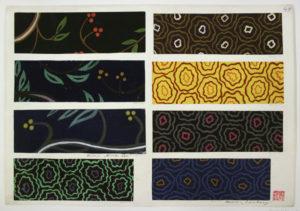As part of a large collection of nearly 1,500 design drawings produced for the textiles and fashion departments of the Wiener Werkstätte (Viennese Workshops), this selection of gouache on paper textile designs range in date from 1916-18.

The three colorways (1988-62-1, 1998-62-2, 1988-62-3) of “Riva See” (“Lake Riva”), a delicate trefoil berry pattern on the left of the sheet,were designed by Artur Berger, who later became a prominent art director in the film industry. The five colorways ( 1988-62-143, 1988-62-144, 1988-62-146, 1988-62-145, 1988-62-147) of “Lemberg” were designed by Willy Foltin, and contrast starkly to the natural imagery of Berger’s design through acidic colors and wavy, concentric circles that produce a dizzying optical effect. While Berger and Foltin were not formally affiliated, and their presence together on this sheet of drawings is a product of the Wiener Werkstätte’s organizational practice, it is nevertheless revealing to examine their work together.
Both textile patterns were designed in the tumultuous years leading up to the end of World War I. Although fanciful and benign at first glance, upon closer inspection, the drawings, through their titles and aesthetics, are material remnants of a period of extreme upheaval within Europe. They reveal political and geographical shifts caused by impending dissolution of the Austro-Hungarian Empire and the creation of a discrete Austrian nation, for the first time governed by a social democracy.
Foltin’s choice of the title “Lemberg” could scarcely be read without a political connotation when considering the political context: the famed six-month Battle of Lemberg took place in 1918 as the start of the Polish-Ukrainian War. Archduke Wilhelm Franz of Austria, a staunch supporter of Ukrainian nationhood, continued to work towards increased rights and representation for the ethnic Ukrainian minority of the region, as well as organizing and leading military campaigns for Ukrainian independence. Lemberg today refers to the present-day city of Lviv, Ukraine. Similarly, Berger’s choice of the title “Riva See” (“Lake Riva”) most likely refers to Riva del Gardo in Trentino, Northern Italy, which was controlled by the Austro-Hungarian Empire from 1815-1918, and dissolved into the Kingdom of Italy at the end of World War I.
With this historical context in mind, the social and political upheaval of the period affected changes in attitudes and practices for architecture and design spheres; ultimately, Foltin and Berger proved to explore socially minded design in their careers.
Berger, an Austrian architect and art director for films, was at first involved in the socialist housing construction projects of Rotes Wien (Red Vienna). He later worked art directing German-language films at Sascha-Film in 1920. Berger and his brother, Josef Berger, co-founded the Bimini-Werkstätten, which produced famed examples of blown and lampworked glass in Vienna. Berger was active designing textiles at the Wiener Werkstätte from 1923-36. He was the co-founder and professor at the Lehrinstitut für Tonfilmkunst (Institute for Sound-Film) in Vienna in 1933. After 1936, he immigrated to the Soviet Union and became active as an art director for the Soviet film company, Meschrapom-Filmstudios. Berger worked for the rest of his life under the name Artur Semenovič in Moscow.
Willy Foltin was an architect and designer from Innsbruck associated with the Wiener Werkstätte in the 1920s. He designed complex intarsia furniture for exhibitions, and produced textile designs for the firm. Although little is known about Foltin’s personal life and circumstances, he published a telling article in the periodical Innendekoration (Interior Decoration) on the concept of empathy in architecture. This article shows Foltin’s adherence to avant-garde approaches to architecture and interior design. A proponent of empathy-theory (Einfühlungstheorie) in the context of interiors, Foltin, among many other avant-garde architects and designers of the period, believed that specific materials could evoke different emotional effects on the viewer depending on scale, color, texture, and lighting.
References
Gmeiner, Astrid and Gottfried Pirhofer. Der Österreichische Werkbund. Vienna: Boehlau, 1985.
Foltin, Willy. “Einrichtung – Einfühlung: Einige Randbemerkungen,” Innendekoration: mein Heim, mein Stolz; die gesamte Wohungskunst in Bild und Wort 35 (1924): 393.
Schweiger, Werner J. Wiener Werkstätte. London: Thames and Hudson, 1990.
Völker, Angela. Moda, Wiener Werkstätte. Florence: Cantini, 1990.
Völker, Angela and Ruperta Pichler. Textiles of the Wiener Werkstätte, 1910-1932. New York: Rizzoli, 1994.
This post was written by Michelle Jackson, cataloguer in the Drawings, Prints & Graphic Design Department, whose work focuses on the Wiener Werkstatte collection.
